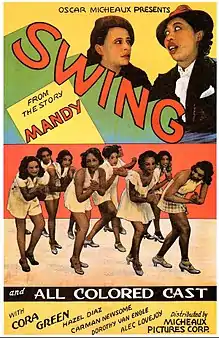Cora Green
Cora Green (December 10, 1895 – died after 1949) was an American actress, singer, and dancer, billed as "The Famous Creole Singer".
Cora Green | |
|---|---|
 Cora Green, from a 1916 publicity photograph | |
| Born | Cora Chambers December 10, 1895 Baltimore, Maryland |
Notable work | Swing (1938), Moon Over Harlem (1939) |
Early life
Cora Chambers was born in Baltimore, Maryland, in 1895, the daughter of Alexander Chambers and Elizabeth Sorrell Chambers.[1]

Career
Chambers began singing professionally by her early teens.[1] Alberta Hunter described her voice as being "between sweet and jazz".[2] In 1931 she was considered "the highest paid colored woman in vaudeville."[3]
She sang in Harlem with blueswoman Mattie Hite in 1914.[2] She was part of the Panama Trio with Florence Mills and Ada "Bricktop" Smith at the Panama Club in Chicago, until the club was closed in early 1917.[4] She had vaudeville acts with Hamtree Harrington[5] and Earl Dancer,[6] and appeared in two revues on Broadway, Strut, Miss Lizzie (1922)[7] and Dixie to Broadway (1924–1925).[8][9]
Her other stage shows included Broadway Rastus (1917),[5] Put and Take (1921),[10] Ebony Showboat (1929),[11] Great Day (1929),[12] Harlem after Dark (1930),[13] Red Light Mazie (1931),[14] Ballyhoola (1932),[15] and Ace in the Hole (1932).[16] She was billed as "Harlem torch singer Cora Green" in a 1933 show in Washington, D.C.[17]
Green sang on a national radio program titled Negro Achievement Hour in 1929.[18] She starred in two musical films, Oscar Micheaux's Swing (1938), and Edgar G. Ulmer's Moon Over Harlem (1939). She also appeared in a musical short, Cora Green: The Famous Creole Singer (1929).[19] During World War II, she toured with the USO in the Persian Gulf, entertaining African-American troops.[20][21]
Personal life
She married her vaudeville partner Earl Dancer.[22] She attempted suicide in 1918,[23] and divorced Dancer in 1919, but they were working together in 1929,[24] and were said to be planning a reunion in 1949.[22] She was in a relationship with musician Horace Henderson in 1932.[16][25]
References
- Salzman, Jack; Smith, David L.; West, Cornel (1996). Encyclopedia of African-American Culture and History. Macmillan Library Reference. p. 1144. ISBN 978-0-02-897364-7.
- Egan, Bill (2004). Florence Mills: Harlem Jazz Queen. Scarecrow Press. p. 25. ISBN 978-0-8108-5007-1.
- "A 'Harlem Tintype'". The Pittsburgh Courier. 1931-10-03. p. 18. Retrieved 2020-06-06 – via Newspapers.com.
- Sharpley-Whiting, T. Denean (2015-02-01). Bricktop's Paris: African American Women in Paris between the Two World Wars. SUNY Press. pp. 21–24. ISBN 978-1-4384-5502-0.
- Cullen, Frank; Hackman, Florence; McNeilly, Donald (2007). Vaudeville old & new: an encyclopedia of variety performances in America. Psychology Press. p. 488. ISBN 978-0-415-93853-2.
- "Double Bill at William Penn". The Philadelphia Inquirer. 1921-03-15. p. 15. Retrieved 2020-06-06 – via Newspapers.com.
- "'Strut, Miss Lizzie' at the Auditorium". The Music News. 14: 14. September 8, 1922.
- Sampson, Henry T. (2005-01-01). Swingin' on the Ether Waves: A Chronological History of African Americans in Radio and Television Programming, 1925-1955. Scarecrow Press. p. 9. ISBN 978-0-8108-4087-4.
- "New Plays". Time. 4: 14. November 10, 1924.
- Sampson, Henry T. (2013-10-30). Blacks in Blackface: A Sourcebook on Early Black Musical Shows. Scarecrow Press. pp. 803, 1039. ISBN 978-0-8108-8351-2.
- "Cora Green's New Show at Lafayette Next Week". The New York Age. 1929-01-19. p. 6. Retrieved 2020-06-05 – via Newspapers.com.
- "Stellar Performers Featured in Classic New Play, 'Great Day'". The Pittsburgh Courier. 1929-06-29. p. 15. Retrieved 2020-06-05 – via Newspapers.com.
- "Harlem after Dark (advertisement)". The New York Age. 1930-07-26. p. 6. Retrieved 2020-06-05 – via Newspapers.com.
- "Alhambra Theatre (advertisement)". The New York Age. 1931-10-10. p. 6. Retrieved 2020-06-05 – via Newspapers.com.
- "Connie's Ballyhoola". The Pittsburgh Courier. 1932-04-09. p. 16. Retrieved 2020-06-05 – via Newspapers.com.
- Dancer, Maurice (1932-07-23). "Harlem by Night". The Pittsburgh Courier. p. 16. Retrieved 2020-06-05 – via Newspapers.com.
- Jr, Wm Forsythe (1933-09-23). "Four 'Dots' Show Dash in Dee Cee". The Pittsburgh Courier. p. 16. Retrieved 2020-06-06 – via Newspapers.com.
- "Cora Green on Air". The Chicago Defender. March 23, 1929. p. 6 – via ProQuest.
- "Cora Green - The Famous Creole Singer". Library of Congress, Washington, D.C. 20540 USA. Retrieved 2020-06-05.
- "USO Troupe Thrills Doughboys in Persia". The Pittsburgh Courier. 1945-01-13. p. 13. Retrieved 2020-06-06 – via Newspapers.com.
- Mullenbach, Cheryl (2013). Double Victory: How African American Women Broke Race and Gender Barriers to Help Win World War II. Chicago Review Press. ISBN 978-1-61374-535-9.
- "Billy Rowe's Notebook". The Pittsburgh Courier. 1949-12-10. p. 18. Retrieved 2020-06-06 – via Newspapers.com.
- "Cabaret Singer Tries Suicide by Gas Route". The Chicago Defender. July 13, 1918. p. 7 – via ProQuest.
- Dismond, Geraldyn (March 30, 1929). "Cora Green Classed as Star without a Temperament". Indianapolis Recorder. p. 2. Retrieved June 5, 2020 – via Hoosier State Chronicles.
- Dancer, Maurice (1932-08-13). "Harlem by Night". The Pittsburgh Courier. p. 17. Retrieved 2020-06-06 – via Newspapers.com.
External links
- Cora Green at IMDb
- Cora Green at the Internet Broadway Database